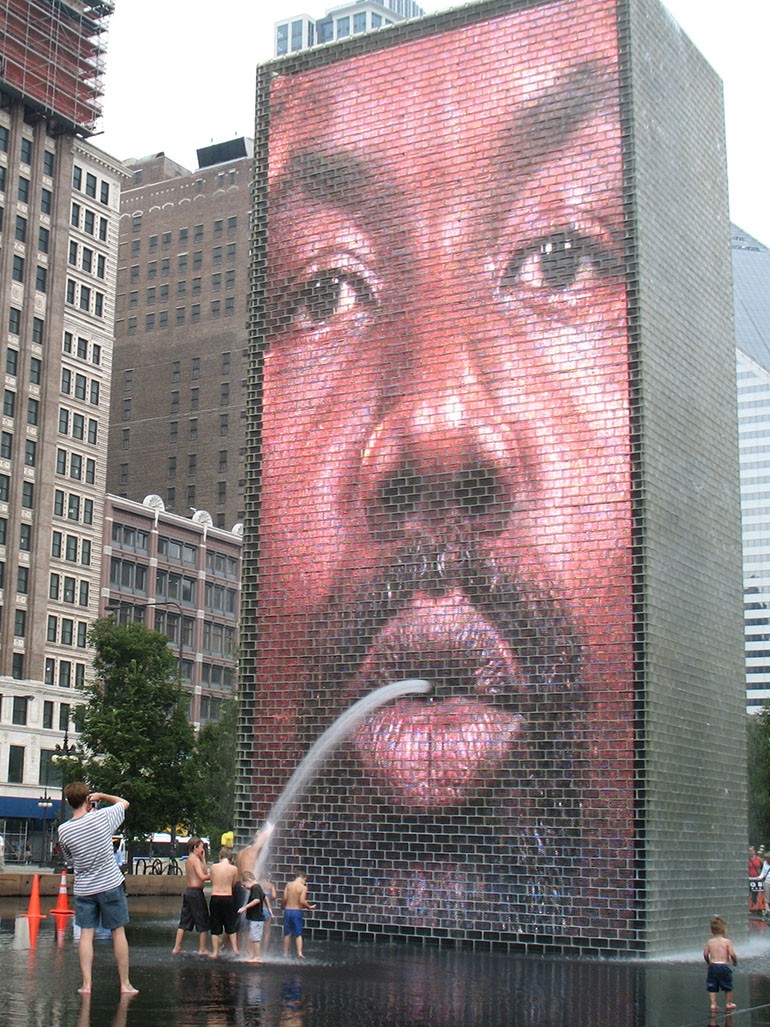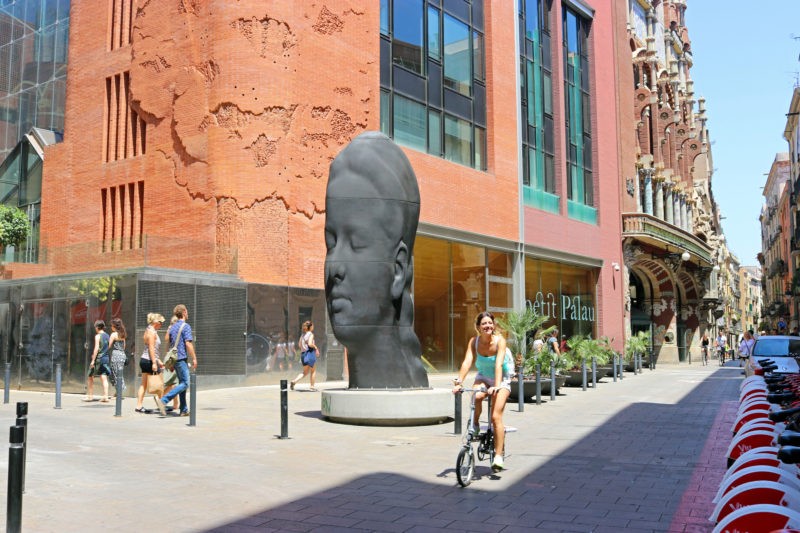
Who is Jaume Plensa?
Jaume Plensa is arguably one of the top sculptors today. He is primarily known for creating huge ethereal sculptures and has also worked with different contemporary art media types, including acoustic installations and video projections.

Plensa is especially known for his large-scale 1, ethereal projects, which he installed in public spaces of major cities around the world and museums and art galleries. Plensa manages to express his ideas by installing lots of his projects in the public spaces, allowing the pieces to be animated by the city and its dwellers.

Education & Teaching
Jaume Plensa was born in 1955 in Barcelona and studied at Sant Jordi School of Fine Arts and Llotja Scholl of Art and Design. Since he started exhibiting in 1980 in his home town Barcelona, Plensa has lived and worked in Brussels, France, Berlin, England and the United States.

He has worked as a teacher at the Ecole Nationale Superieure des Beaux-Arts in Paris and is regularly in contact with the School of the Art Institute of Chicago as a part-time professor. Plensa has traversed the world, giving lectures and courses at universities, cultural institutions, and museums.

How does he create his sculptures?
Jaume Plensa usually starts his sculptures by making 3D digital images of his object or subject. Using computer modeling, he designs the images by elongating them and abstracting the features, changing the details to lose the “journalistic sense of the portrait to become an icon.”

Using an industrial prototyping device, he generates a plastic foam model on the scale, which he models by hand. The artist repeats the process many times before making a full-size sculpture.

Plensa uses various media to express his thoughts, including glass, aluminum 2, bronze, water, light, steel, video, and sound. He has also produced an extensive amount of works on paper.

The ideas behind his work
Why public space?
Why public space?
Explaining why he likes displaying in public spaces, Jaume Plensa said in an interview 34:
Public spaces are the ones that allowed me to become well-known, but the reason why is simply because normally nobody assigns to them the value of a first category place. They are considered substitutes as the typical “roundabout.” But roundabouts are neither good nor bad: it depends on what we do with them, like everything in life. For me, public spaces are very interesting for sculpture and art in general. In public spaces, a kind of direct relationship between people, who have not sought it, and the artist comes to life. It is a relevant artistic issue. It represents the artist among other people, and thus, the piece of art must be very respectful. Public spaces do not belong to artists: they belong to everybody, to people as citizens, and as individuals. The artist thus needs a lot of humility.

Romanticism & beauty
By juxtaposing the poetic and the intellectual, Jaume Plensa 5 manages to come up with evocative sculptures that have a robust conceptual foundation. While most conceptual artists usually feel the need for refusing beauty to convey ideas, the romanticism and beauty of Plensa’s sculptures can make his ideas more tangible.
He primarily does this through the interaction between the artwork and the viewers. His sculptures are often placed in busy and chaotic public spaces to provide a sanctified haven where the inhabitants can play, laugh, reunite, relax, or collect themselves.

Interaction with the public
The interaction between his work and the audience and the entire city, in general, gives a breath of life to Plensa’s sculptures. Even in all the chaos and hustle of city life, Plensa’s work provides a sanctified haven where people can play, laugh, collect themselves or reunite.
Material
The artist has tried to communicate the internal versus external, the collective versus individual, and private versus public space. These ideas can also be seen in his most recognizable sculptures, such as his immaculate sculptures of angelic teenage girls’ faces and human bodies.
He uses alabaster stone and a combination of brightly colored LED lighting to highlight the translucency and link the internal psychological thoughts of a human with the exterior façade 6. His works indicate how he grants the element of presence to his concepts, which are usually not cold or hostile but gentle and welcoming.
Plensa consistently made sculptures with their eyes closed, portraying their isolation from the world and the link to their inner self. However, despite their withdrawal from the world, their outer space still brings them to life by projecting an element of naturalism throughout their unearthly structures. This way, the artist, again, successfully connects two opposites.
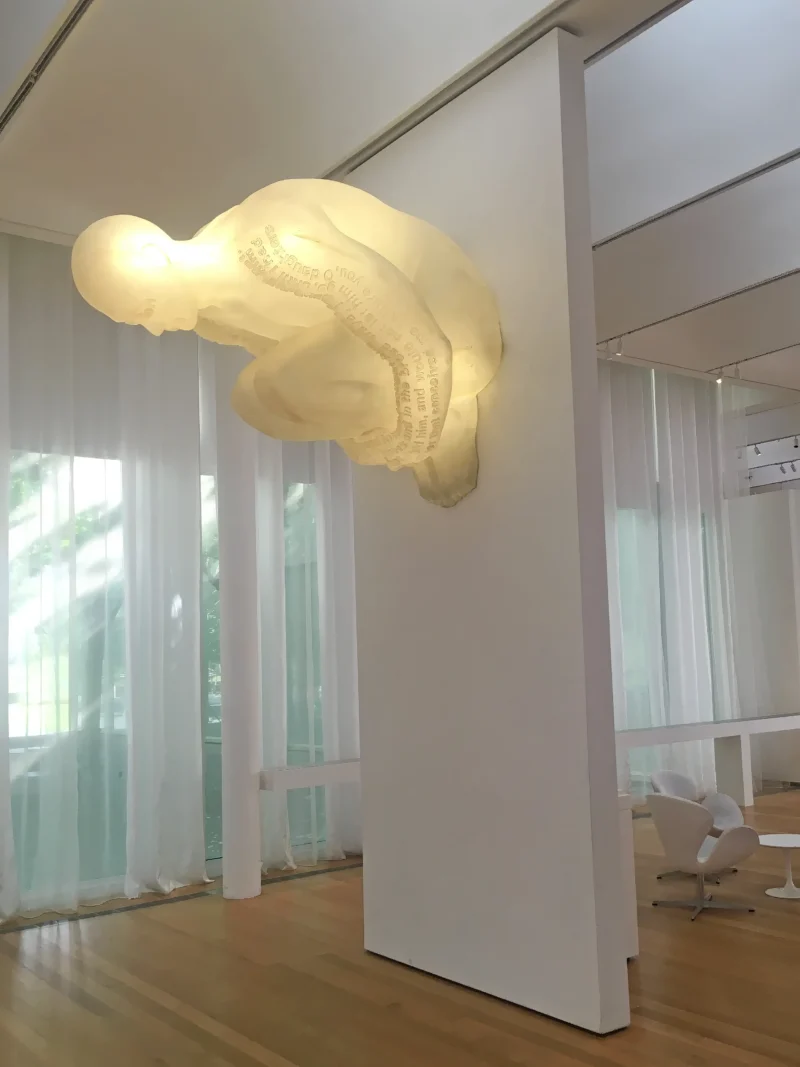
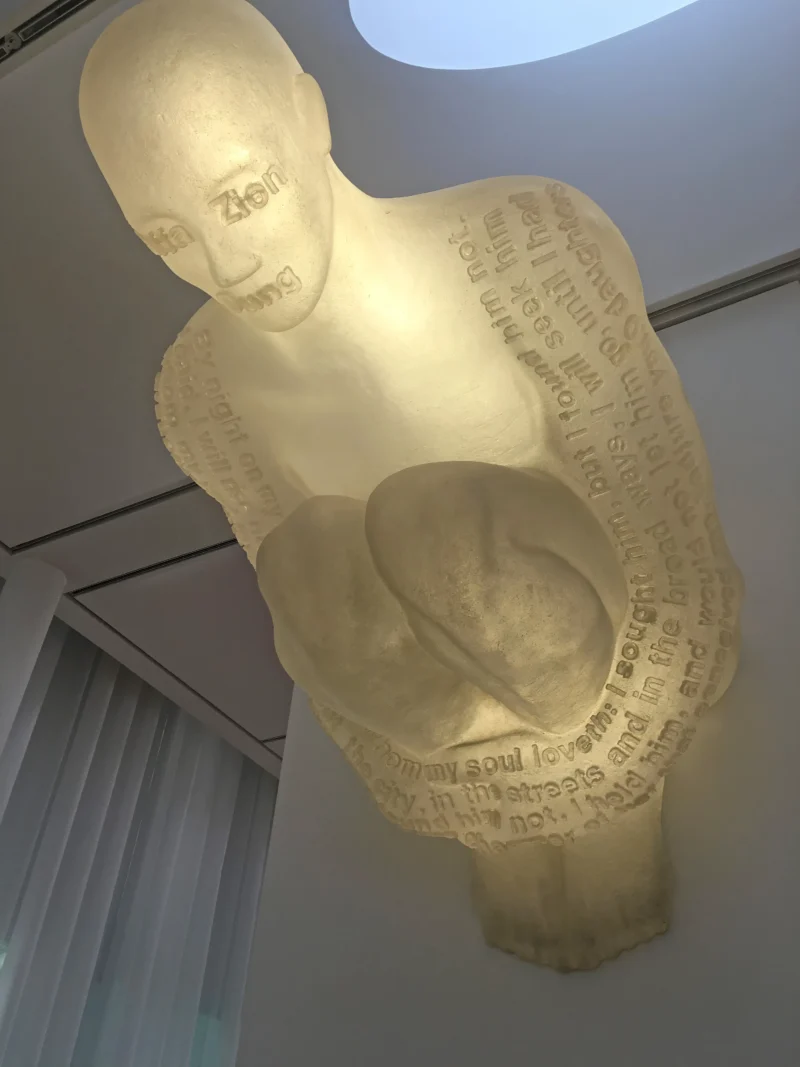
What inspires Plensa?
Jaume Plensa is an ardent reader and his work is inspired by poetry and literature. He cites Shakespeare, Goethe, and Black as some of his major inspirations. Throughout his works, Plensa has managed to bring physicality to the intangible sounds of verbal language and poetry, paying homage to his deep love of all things literature.
This includes works like the Nomade sculpture, allowing the audience to look through the spaces between the letters and see humanity as a single unified piece. Doing this, he is not trying to express the meaning of words, rather the material essence.
The letters used in the sculptures are not necessarily sensible in terms of words and sentences. However, they establish the traditional nature of language and its fundamental essence, which functions as a symbol.
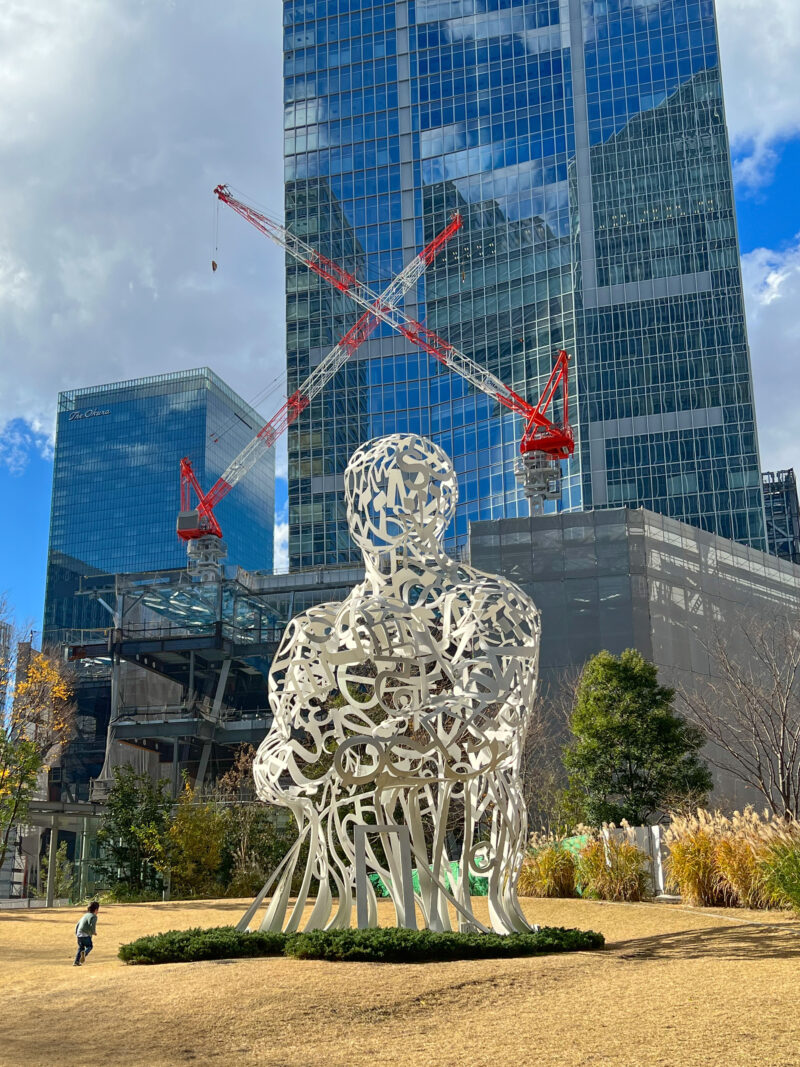
Conclusion
With different materials, the shape of his work took different formations, and despite this, Plensa maintains that all his works are the embodiment of the same core concept.
Plensa tries to avoid negative assertions in all his works and instead propagate only hope, unity, and beauty, creating the feeling of togetherness despite the societal hurdles that discrete humankind.
Plensa’s main idea throughout his works is a gentle look at us and our connection with the external and internal world. If one can keenly peep through the hollows between the letters used to build the sculpture, one will be able to see humanity as a whole.
Video: The Iconic Public Sculpture Art of Jaume Plensa
24 min 9 sec
Artworks & Projects
Recent works (2018)
Artworks & Projects
Recent works (2018)
The largest project ever made by Plensa to date is the Crown Fountain. It was installed in Chicago’s Millennium Park back in 2004 and quickly became one of his most prominent works. Crown Fountain led to numerous commissions, piling to the list of projects by the artist in public spaces.
Some of the most recent projects include Pacific Soul (2018) in San Diego, California, Julia (2018) in Madrid, Spain, and Voices (2018) installed in 30 Hudson Yards, New York and Behind the Walls (2018) installed at New York’s Rockefeller Center.
Alchemist, 2010
Alchemist was installed in 2010 at the entrance of the Stratton Student Center overlooking the main gate of the Massachusetts Institute of Technology, Cambridge, Massachusetts, and other universities.
The work is a hollow seated sculpture just like most of Plensa’s works, except that this one comprises lots of numbers and mathematical symbols. Alchemist is a dedication to MIT’s traditional STEM-styled teaching and research.
Crown Fountain, 2004
The most successful work of the artist to date in the public place is the Crown Fountain in Chicago’s Millennium Park 78. The sculpture is formed by two perpendicular towers adorned with LED screens, and it easily explains why the artist’s career went straight to the top after its installation.
The fountain on the sculpture has made the park one of the most visited playgrounds in the city. Even Plensa himself couldn’t resist it as he revealed he liked visiting the sculpture to see how people interact with it.
While Crown Found offers a distinguished playful experience, this work still conveys the artist’s underlying ideas. The sculptures depict the presence of duality, which can be noticed across Plensa’s works.
Dream, 2009
Dream was first installed in Liverpool in 2007. The sculpture comprises an elongated silvery structure, rising 20 meters high and weighing about 500 tons. The statue 9 was carved to depict the bust of a young girl with her eyes closed, resembling someone in deep meditation. The exterior of the sculpture is layered in glittering white dolomite. Plensa chose this material instead of coal, which is mined in abundance in the region.
Echo, 2011
When constructing Echo, the bust was cast in fifteen pieces in Spain and lumped together using steel scaffolding. Speaking about the unique process, Plensa stated in the NY Times 1011:
It comes from an old tradition that the Romans used when they built the columns in their temples. They built them in slabs with a fragile sheet of lead in between. It produces an amazing sense of transparency.
Exhibition at Yorkshire Sculpture Park, 2011
In 2011, numerous of the artist’s works and sculptures were displayed at the Yorkshire Sculpture Park in West Bretton, England. Due to the large size of the exhibition, the site was awarded a national recognition honor as the Most Magnificent Attraction in 2011. Up to this day, this project remains the most encompassing exhibition devoted to the artist’s work.
Human Landscape, 2015-2016
Between the year 2015 and 2016, the project Human Landscape has voyaged across several North American museums such as Cheekwood Estate and Gardens and The Frist Center for the Visual Arts in Nashville, Tennessee, the Tampa Museum of Art in Tampa, Florida, as well as the Toledo Museum of Art in Toledo, Ohio.
